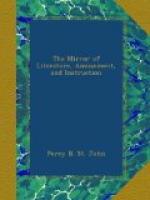From the Delectable Mountains, the way lies through the logs and briers of the Enchanted Ground, with here and there a bed of soft cushions spread under a green arbour. And beyond is the land of Beulah, where the flowers, the grapes, and the songs of birds never cease, and where the sun shines night and day. Thence are plainly seen the golden pavements and streets of pearl, on the other side of that black and cold river over which there is no bridge.
All the stages of the journey,—all the forms which cross or overtake the pilgrims,—giants and hobgoblins, ill-favoured ones, and shining ones,—the tall, comely, swarthy Madam Bubble, with her great purse by her side, and her fingers playing with the money,—the black man in the bright vesture,—Mr. Worldly-Wiseman, and my Lord Hategood,—Mr. Talkative, and Mrs. Timorous,—all are actually existing beings to us. We follow the travellers through their allegorical progress with interest not inferior to that with which we follow Elizabeth from Siberia to Moscow, or Jeanie Deans from Edinburgh to London. Bunyan is almost the only writer that ever gave to the abstract the interest of the concrete. In the works of many celebrated authors, men are mere personifications. We have not an Othello, but jealousy; not an Iago but perfidy; not a Brutus, but patriotism. The mind of Bunyan, on the contrary, was so imaginative, that personifications, when he dealt with them, became men. A dialogue between two qualities, in his dream, has more dramatic effect than a dialogue between two human beings in most plays.
The Pilgrim’s Progress undoubtedly is not a perfect allegory. The types are often inconsistent with each other; and sometimes the allegorical disguise is altogether thrown off. The river, for example, is emblematic of death; and we are told that every human being must pass through the river. But Faithful does not pass through it. He is martyred, not in shadow, but in reality, at Vanity Fair. Hopeful talks to Christian about Esau’s birthright, and about his own convictions of sin, as Bunyan might have talked with one of his own congregation. The damsels at the House Beautiful catechise Christiana’s boys, as any good ladies might catechise any boys at a Sunday School. But we do not believe, that any man, whatever might be his genius, and whatever his good luck, could long continue a figurative history without falling into many inconsistencies.
The passages which it is most difficult to defend, are those in which he altogether drops the allegory, and puts into the mouth of his pilgrims religious ejaculations and disquisitions, better suited to his own pulpit at Bedford or Reading, than to the Enchanted Ground or the Interpreter’s Garden. Yet even these passages, though we will not undertake to defend them against the objection of critics, we feel that we could ill spare. We feel that the story owes much of its charm to these occasional glimpses of solemn and affecting subjects, which will not be hidden, which force themselves through the veil, and appear before us in their native aspect. The effect is not unlike that which is said to have been produced on the ancient stage, when the eyes of the actor were seen flaming through his mask, and giving life and expression to what would else have been an inanimate and uninteresting disguise.




